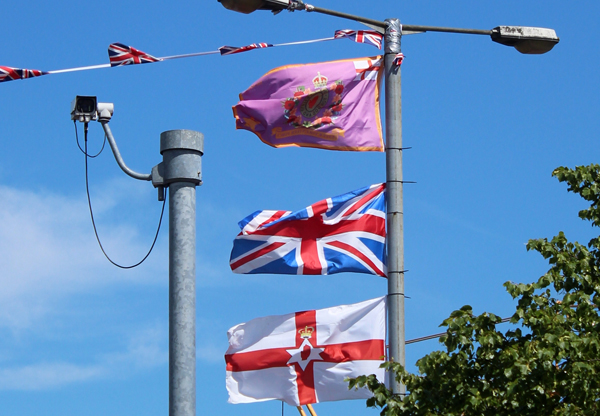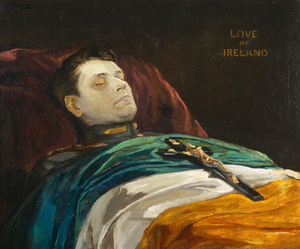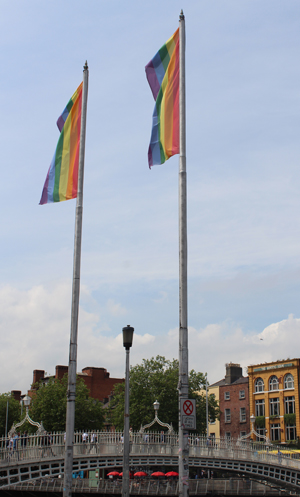The role of flags and emblems in Irish commemorations
Published in Features, Issue 5 (September/October 2019), Volume 27In this ‘decade of commemorations’, it is worth reflecting on Ireland’s long, contentious yet colourful history of commemorations and the role that flags and emblems have played throughout it.
By Stan Zamyatin
Flags, emblems and commemorations have represented the aspirations of Irish people over centuries, reflecting the political movements that have taken place on all sides. Their design, introduction and use have always had political aims that have been used to further agendas in different ways. It should be seen that commemorations are less about the past and more about the time in which they occur and the future hoped for by those commemorating. In this sense the Irish tricolour can be seen to be the embodiment of this, as it represents a hoped-for future that has yet to be achieved.

Above: Loyalist lamppost flags in Belfast—the flying and painting of different flags and colours serve to reinforce national identities and affiliations.
Expressions of identity
One of the most fundamental needs that all humans have is for a sense of identity and belonging. A strong feature of this is the human attachment to flags. It is undeniable that flags play a very important role in encouraging a sense of pride amongst people, as they provide a real and tangible sense of identity. They serve as symbols for people to recognise and unite under, based on shared beliefs and values. Thus, when certain beliefs and values clash, so do the flags that represent them. The tricolour, which commemorates its 170th anniversary this year, reflects this clash of identities—orange and green, the two rival colours of the 1798 United Irish Rebellion.
Following independence in 1922, the divisions brought about by partition, civil war and a residual southern unionism created fertile ground for the clashing of symbols. Armistice Day or ‘Poppy Day’, as it was informally called, was originally a relatively popular event but became very divisive. The poppy began to be officially sold in Ireland in 1925, in memory of the Irish who died fighting in the First World War. This did not sit well with some republicans and led to widespread violence, flag-burning and ‘poppy-snatching’. The following year, for the tenth anniversary of the Easter Rising, Cumann na mBan introduced the green, white and orange ‘Easter Lily’ as a rival nationalist symbol to the loyalist poppy and Union Jack, which continued to be displayed. In the same year Fianna Fáil was founded, which under de Valera began to appropriate the Rising for its own political advancement. This was seen during major commemorations in 1935, for the comparatively minor nineteenth anniversary of the Rising, when the party introduced the ‘Easter Torch’ as an alternative to the lily. Dominic Bryan has observed that ‘symbols are invented, their political value or importance can rise and diminish and they can go out of existence’. As it happens, the torch symbol never took off, while the two floral emblems became marginalised at different ends of the political spectrum, where they remain to this day. Historically, Fine Gael was sympathetic to the recognition of Irish service in the British military, which was seen last year when An Taoiseach Leo Varadkar controversially wore a ‘shamrock poppy’. This, however, also reflected the greater recognition now afforded to the Irish who lost their lives during the war and the changing and more inclusive Irish collective memory. Symbols are never static and, like past events, often become reimagined and reshaped to fit a changing identity. The shamrock poppy is an example of this, as it was introduced in 2011 as a contemporary symbol of ‘compromise’ and ‘shared history’.
One place where the display of flags and emblems during commemorations is most controversial is Northern Ireland. The continuing flag issues are reflective of the deep divisions that still exist between the Catholic and Protestant communities—the ‘peace walls’ only serve as a testament to this divide. The flying and painting of different flags and colours serve to reinforce national identities and affiliations. Their displays on murals, kerbstones, lampposts and many other places act as territorial markers for loyalists and republicans alike.
Claim to authority

Above: Sir John Lavery’s ‘Love of Ireland’ (1922), depicting a tricolour-draped Michael Collins lying in state. The funeral not only commemorated his death but also the birth of the Irish Free State, which would be officially established three months later on 6 December 1922 under the new State flag. (Dublin City Gallery: The Hugh Lane)
Flags are not only powerful symbols; they are also symbols of power itself. One of the ways in which power and authority have been demonstrated and asserted is at funerals and their commemorations. Many of us are aware of the political, social and symbolic role that funerals have played in Irish history, but how many of us know that some of the earliest uses of flags and emblems symbolising Ireland are found in the funeral processions of English sovereigns from the fifteenth century? There they appear as one of many emblems to show the individual domains of the sovereign and to create the appearance of continuous order and authority.
The Fenians came to understand the power of graveside commemorations and utilised them for their own political benefit. Most noteworthy was the funeral of Jeremiah O’Donovan Rossa in 1915, which was used by Tom Clarke to unite the various republican factions and bring about the eventual Easter Rising the following year. Iconographically the funeral was important, as it clearly displayed the Irish tricolour draped over the coffin. After the tricolour was introduced in 1848, it was seldom used and became a symbol of separatism, and therefore its use in 1915 was not only rare but also radical. The widespread recognition of the tricolour over the green harp flag in 1916 represented a new imagined Ireland by a new generation of republicans. At Ireland’s first two State funerals—of Arthur Griffith and Michael Collins—the flag once again played an iconic role, as can be seen in the images of Collins’s funeral procession, where c. half a million people lined the streets to pay their respects, including British soldiers. The funeral not only commemorated his death but also the birth of the Irish Free State, which would be officially established three months later on 6 December 1922, under the new State flag. Just as in the fifteenth century, this procession attempted to show the continuation of power and order despite the passing of the leader.
Strengthening of relations

Above: Two of the 150 flag-poles erected along Dublin’s Liffey quays for the 1932 Eucharistic Congress—now used annually for a variety of celebrations, such as LGBTQ Pride.
Commemorations are in many ways like Christmas—they also involve myth-making, pageantry and decorations, and people are usually obliged to give presents. The act of giving gifts has always been an important part of human society, as it helps both to develop and to improve relationships. In the case of Ireland, flags have facilitated the reinforcing of relations, for example with the United States and with France, and have aided reconciliation, primarily with Britain.
In 1898, for the centenary of the United Irish Rebellion, two flags were presented to the Centenary Committee by a female Irish-American association. In 1959, for the anniversary of the Battle of Fontenoy, the replicas of five colours of the Irish Brigade were given as gifts from France to Ireland. And in 1963, during President Kennedy’s historic visit, he presented the second Colour of the 69th New York Regiment to the Dáil, as part of the earlier centenary of the Battle of Fredericksburg. During the 1916 Rising a number of flags were taken as ‘war trophies’, which have over the years been returned or bequeathed to museums as gestures of goodwill. The ‘Irish Republic’ flag that flew over the GPO was returned for the 50th anniversary of the Rising in 1966. For the centenary in 2016, pieces of the Jacob’s factory tricolour were donated to Glasnevin Cemetery, while a Fianna Éireann banner was loaned to Dublin City Council, a tricolour to Limerick City and County Council and a green harp flag to SIPTU. These examples show just how flags can promote dialogue and foster deeper mutual understanding and respect.
Demonstration of faith
Flags have always been considered sacred objects and therefore their religious role should not come as a surprise. Neil Jarman noted that ‘commemorative parades have been documented as a part of Irish social, religious and political life since the late fifteenth century’. These parades were held by the guilds, with Corpus Christi being one of the main commemorative days. In fact, the carrying of the Irish national, Vatican and other flags at the head of Corpus Christi processions was commonplace in Ireland until the 1970s.
In 1932, as part of the International Eucharistic Congress, the 1,500th Anniversary of St Patrick’s arrival was commemorated. The Congress was one of the most colourful and vibrant events in Irish history and saw almost every town and village awash with flags, especially those of the Vatican City, which had only recently been established. The commemorations proved to be psychologically healing, as they allowed, amongst many things, for the impoverished to briefly escape the economic realities of 1930s Ireland. Incredibly, many paid for their own flags and bunting to decorate their local areas.
While the centenary of Catholic Emancipation in 1929 celebrated a political event, the Eucharistic Congress observed a religious one that proved to be political. Aside from demonstrating his faith, de Valera used it to reinforce his political image of a new conservative and Catholic Ireland. While the non-material cultural remnants are well known, what is less well known is that 150 flag-poles were erected along the Liffey quays, and are still there today. They are used annually by Dublin City Council to fly flags for various celebrations, such as Dublin LGBTQ Pride. In 1979 they were decked in the papal colours for the visit of John Paul II, as they were for Pope Francis’s visit earlier this year.
Conclusion
As we have seen, flags, emblems and commemorations have long been divisive and controversial issues in Ireland. Their contradictive nature continues to be a source of conflict and peace, a source of unity and division, yet their powerful symbolism endures to reinforce and sustain our connectivity with our national, cultural, religious and political identities. As we come to commemorate the more difficult parts of our nation’s history, it is important to see and understand both the value and the limits of symbols. As John Hume’s father once told him, ‘You can’t eat a flag’.
Stan Zamyatin is head of Flag and Heraldic Studies at the Genealogical Society of Ireland.
FURTHER READING
D. Bryan, Orange parades: the politics of ritual, tradition and control (London, 2000).
G.A. Hayes-McCoy, A history of Irish flags from earliest times (Dublin, 1979).
N. Jarman, Displaying faith: orange, green and trade union banners in Northern Ireland (Belfast, 1999).
S. Zamyatin, Flagging Ireland: Irish guide to flag design (Dublin, 2015).
















